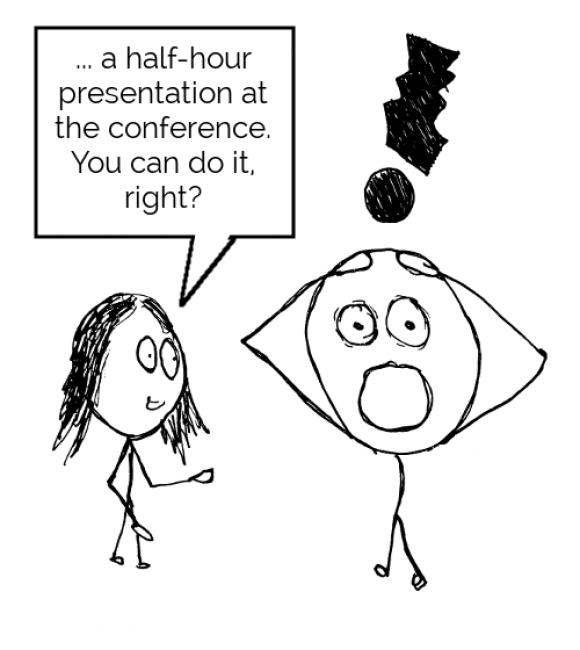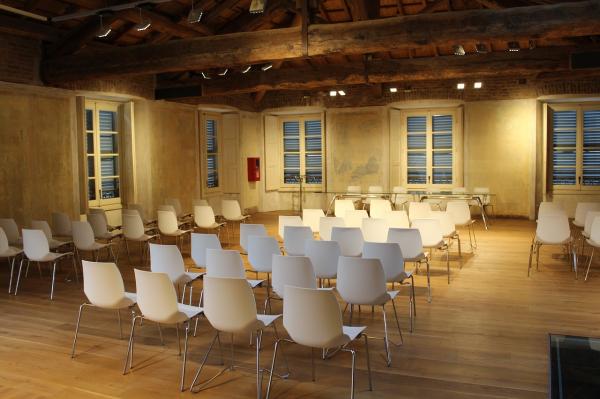OK. So you’ve practised your presentation.
You’ve done the research, the script’s perfect and the slides are looking awesome.
Then the big day arrives.
You’re up there on stage, and they’re all looking at you. Waiting for you to say something clever.
You know what that means, right?
Well, sure – you feel so nervous that all you want to do is run to your hotel room, lock the door and hide in the bath.
But there’s a better way of dealing with it than that.
1. Deal with nervousness
OK. The big one!
This is what causes you to look like this when your boss has just told you to do the presentation:

The fear!
How to overcome the fear?
Well, my first piece of advice is …
Don’t try to overcome the fear
No matter how well prepared you are, there will always be the nerves.
And that’s a good thing!
That feeling of nervousness can give you energy and can make a dull presentation into an engaging one.
Spend some time a little before the presentation telling yourself that you’re not nervous; you’re excited – you’re passionate!
This simple exercise will help you use the fear for good! A bit like Batman.
Yeah – you’re Batman!
Go, Batman! Go!
Use a lower voice
When we’re nervous, our voices tend to rise in pitch.
I noticed this when I first started filming myself for work. I was
having problems sounding natural – mostly because I was feeling nervous
in front of the camera.
Then my partner said, “Lower your voice!”
It worked!
Immediately I could hear that I sounded more natural and calm.
As soon as I heard myself sounding calmer, I started feeling calmer.
Simple, right? But effective!
Like Batman.
2. Master what you’re doing with your voice

We mentioned lowering the pitch of your voice to combat nerves.
But there are a few other things you can do to make sure that everyone in the room really listens to what you’ve got to say.
Pause. Pausing is good.
It really is.
Sure, you know what you’re talking about; you’ve (hopefully) gone over the script a hundred times.
But remember that this is the first time your audience has heard these words.
That means they want to have time to think about them.
Every time you get to the end of a section, or whenever you’ve made an important point … stop!
Let the information sink in.
A few seconds can feel like an eternity to you but is just about enough time for your audience to process what you have to say.
It also signals to them that you’ve just said something important. So
they should jolly well listen to it and stop thinking about the last
Facebook cat video they saw.
Speak more slowly than you think you need to
Again – this is the first time they’ve heard what you’ve got to say.
So say it slowly.
The fact that you’re nervous and the fact that you’ve said the same
words over and over again will mean that you instinctively want to talk
quickly.
But don’t!
Slow it down by 30 or 40 percent.
Try to avoid droning
I can’t count the number of times I’ve seen people give talks in their robot voice.
You know the one, right?
That voice that sounds like Artificial Intelligence reading out a Wikipedia article on tax law reform between 1887 and 1888.
That voice that makes you want to go outside and pick a fight with a
bear – just because it would be something else to do other than listen
to that person.
Some people think that if you want to sound authoritative, you need
to be boring and unemotional, otherwise people won’t take you seriously.
Not true!
The words in your script are what gives you authority.
The way you say them makes you engaging.
3. Master what you’re doing with your body and the space it’s in

Whatever you do, for God’s sake, don’t pace!
Pacing is the classic sign of nervousness.
You know what I mean, right? Walking up to the side of the stage,
turning round, and walking back to the other side, turning round and
doing it again and again.
It makes you look like a tiger in a cage – nervous.
And that makes everyone else feel nervous.
Then you’re stuck in a room giving a presentation to a hundred people
who are all in a state of mild panic and who aren’t listening to a word
you’re saying.
Instead, walk purposefully to a particular spot. Stay there. Talk a bit. Then go somewhere else.
Like Batman.
Don’t self-block
“What’s self-blocking? And also, how did you get your hair looking so good?” I can hear you ask.
OK – one question at a time.
Have you ever noticed what happens to your body when you’re feeling nervous in front of people?
You might try to make yourself smaller.
Or perhaps you cross your arms (and maybe also your legs).
Or you put your hands in your pockets or behind your back.
These are all defensive gestures and happen especially when you’re feeling threatened.
Avoid them at all costs!
One way to do that is to look at the audience. You’ll see human, interested faces – some will even be friendly.
Once you do this, you’ll realise that there’s no need to feel defensive, and hopefully your body will get the message, too.
As for my hair – well, that’s a secret. Sorry!
Know the room!
This is a simple technique but can work wonders for your confidence.
Get to the room before anyone else does.
Spend some time with it.
Get to know it.
Buy it flowers.
Walk up and down the stage a few times.
Go and sit where the audience will sit so you can see what it’ll look like from their point of view.
Oh – and make sure that projector works!
4. Establish a relationship with the audience
In a way, this is the most important thing you can do during your presentation.
Your computer could explode, your script could catch fire and all your hair could suddenly transform into snakes.
But none of that will matter if you have established a good relationship with the audience.
Here’s how:
- Establish a connection before you start
While people are coming into the room, it’s very tempting to start
looking through your notes or checking the projector settings for the
tenth time.
These activities are probably only going to make you more nervous.
Instead, watch people come in.
Make eye contact.
Say “Hi!”
Even ask some questions or crack a joke.
Here’s one for free: “There are two types of people in this world:
those who have learned the present perfect, and those who isn’t.”
All of this will bring the audience onto your side before you’ve even begun.
- Remember – it’s all about them!
This presentation is all about the audience.
Remember that at every step.
When you walk on stage, tell yourself, “It’s about them.”
When you speak, remember you’re doing it for them.
Get into the mindset of giving, not taking.
If you do this, the audience will notice, and they will be on your side all the way.
Like Robin to your Batman.
Go, Batman! Go!
- Eye contact is awesome!
When you’re nervous, it’s very easy to avoid eye contact and look at
the back of the room, through the window at the streets full of people
walking about – happy people, free people. People who don’t have to give
a presentation right now.
Force your eyes away from the window!
Look at the people in the room.
Show them you’re there for them!
What’s more, once you’ve faced your fear, you’ll feel calmer, more
focused and ready to give the most awesome performance of your life!
Try to give everyone equal attention. Look at one person for a couple of sentences, then move onto another.
If you see someone shaking her head or someone looking at you like he wants to kill you, don’t worry.
He (probably) doesn’t want to kill you. Some people just look like that.
Just move on and focus on the positive faces – it’ll give you more energy and improve your performance dramatically.
OK. There we have it: four tips to use during your presentation.
Are you ready for it now?
Just remember: You’re Batman!
Go, Batman! Go!
Did you enjoy reading this article? Here’s more advice on effective public speaking.
Making Public Speaking Easy #1: Preparation
Making Public Speaking Easy #3: Post Mortem
Gabriel Clark, LOS Consultant & Clark and Miller Co-founder
